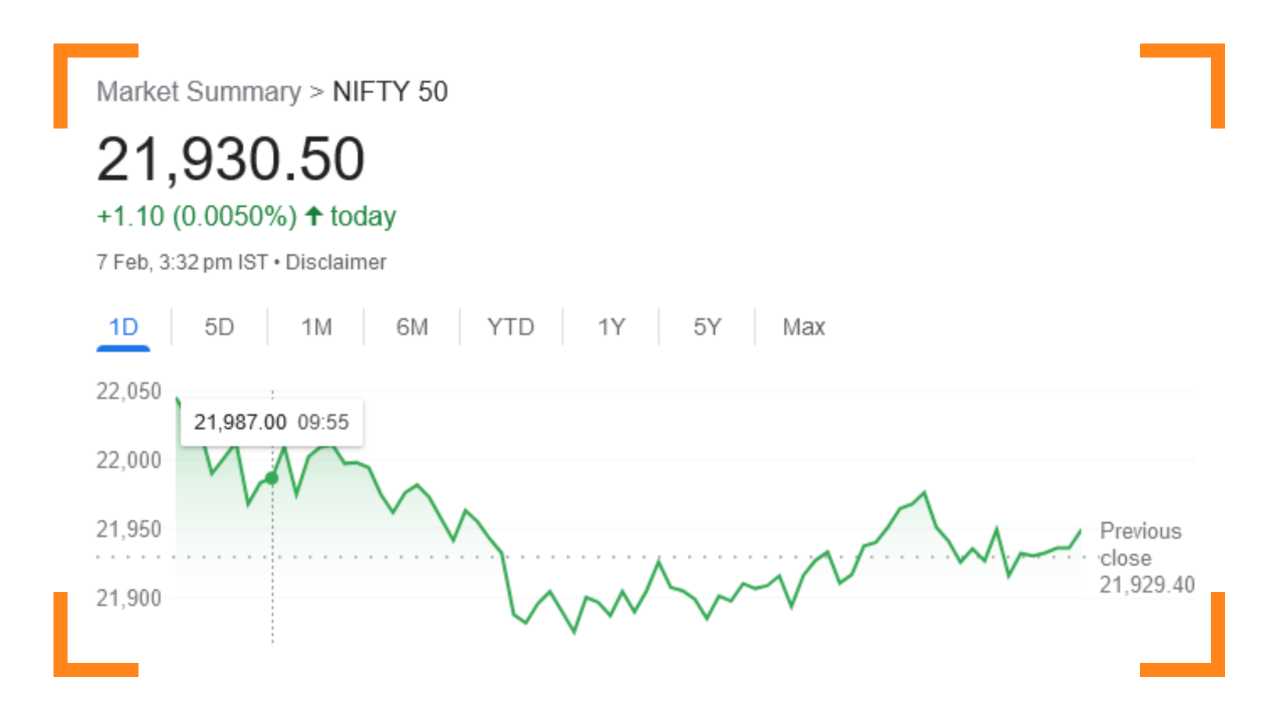Nifty Closed at 21,930; Nifty Prediction for Tomorrow

Nifty Prediction for Tomorrow
Market Analysis: Indian Stock Indices Navigate Cautiously Amidst Volatility
The Indian stock market displayed a day of subdued performance on February 7, characterized by marginal movements in both the Sensex and Nifty.
The trading session, marked by heightened volatility, concluded with the Sensex recording a slight dip of 34.09 points or 0.05%, settling at 72,152.00.
Conversely, the Nifty displayed a modest uptick of 1.10 points or 0.01%, concluding at 21,930.50. The market exhibited caution among investors as they awaited the crucial policy update from the Reserve Bank of India (RBI).
Market Overview:
The intricate dynamics of the market revealed a nuanced pattern, with 1932 stocks marking gains, 1339 witnessing declines, and 60 remaining unchanged.
Notably, the BSE Midcap index surged by 1.3%, while the Smallcap index registered a 0.4% increase. The sectoral performance exhibited a mixed trend, with notable gains in PSU Banks, Metal, Power, Pharma, and Realty, ranging from 0.5% to 3%. In contrast, the IT sector faced a setback, recording a 1% decline.
Top gainers on the Nifty included State Bank, Grasim Industries, JSW Steel, HDFC Life, and Axis Bank. On the flip side, Tech Mahindra, Power Grid Corporation, Infosys, Adani Ports, and TCS experienced declines, reflecting the diverse movements within the market.
Insights and Analysis:
As market participants look ahead to February 8, analysts provided valuable insights into potential movements and key factors influencing the market sentiment.
Jatin Gedia, a market analyst from Sharekhan, observed that Nifty displayed a positive opening on the given day and consolidated throughout the trading session.
Chart analysis indicated a tight trading range in recent weeks, with 22000 – 22050 acting as a robust resistance and hourly moving averages (21800 – 21900) serving as support.
Gedia emphasized the necessity for a decisive move beyond this range to determine the market’s direction. Until such a move occurs, the market is likely to witness stock-specific actions and sector rotation.
Bank Nifty, after three consecutive days of decline, closed positively. Analysts anticipate a retracement towards 46300-46500 in the upcoming sessions, with support identified at 45500-45400.
This projection underscores the importance of monitoring the banking sector’s movements, which often play a pivotal role in influencing overall market sentiment.
Aditya Gaggar, Director at Progressive Shares, highlighted the day’s market dynamics. Nifty initially lost its gains in the morning trading session, slipping to lower levels.
However, a slight recovery from these lower levels in the later trading session helped Nifty end the day in the green at 21,930.50, reflecting a gain of 1.10 points.
Gaggar noted that except for the IT sector, all other sectoral indices closed with gains. The most significant rise was witnessed in PSU banks and realty, showcasing the resilience and strength of these sectors in the current market conditions.
Mid and smallcap indices outperformed the Frontline Index, with gains of 0.75 percent and 0.71 percent, respectively.
Gaggar emphasized that Nifty 50 index is currently moving in a narrow range of 21,700-22,050. A breakout in either direction, up or down, will likely determine the market’s future trajectory.
This underlines the significance of closely monitoring the key resistance and support levels to identify potential trend reversals or continuations.
Technical Analysis:
Delving into technical analysis, it’s essential to consider the critical levels and moving averages that provide insights into potential price movements.
Jatin Gedia highlighted that the daily chart of Nifty indicates a tight trading range in recent weeks. The resistance zone of 22000 – 22050 is significant, acting as a barrier to further upside movements. On the other hand, hourly moving averages in the range of 21800 – 21900 have emerged as a crucial support level.
To establish a clear direction, Nifty needs to make a decisive move beyond this small range. Until such a breakout occurs, market participants can anticipate continued stock-specific actions and potential sector rotations. Gedia identified support for Nifty at 21730 – 21680, while immediate resistance lies in the zone of 22000 – 22053.
Bank Nifty, after witnessing a decline for three consecutive days, showed resilience and closed in the green. Analysts anticipate a retracement towards 46300-46500 in the next few trading sessions.
This positive outlook is supported by identified support levels at 45500-45400. The banking sector’s performance is often closely linked to the overall market sentiment, making it a crucial barometer for investors and traders.
Aditya Gaggar underlined that Nifty 50 index is currently navigating within a small range of 21,700-22,050. The breakout from this range, either upward or downward, will likely determine the market’s future trajectory.
This emphasizes the importance of monitoring key technical levels and market developments to position oneself effectively in the evolving market scenario.
Sectoral Trends:
Examining the sectoral trends, it’s evident that except for the IT sector, all other sectoral indices closed with gains on February 7. PSU Banks and Realty sectors particularly stood out, witnessing the most significant growth.
The resilience displayed by these sectors reflects their strength in navigating market conditions and potentially signaling opportunities for investors.
PSU Banks, often influenced by economic policies and regulatory changes, showed notable gains. The positive momentum in this sector could be attributed to factors such as improved economic outlook, potential policy changes, or positive sentiments surrounding banking stocks.
Realty, another standout performer, exhibited substantial growth. The real estate sector’s performance is closely linked to economic indicators, interest rates, and overall market sentiment.
Positive movements in realty may indicate confidence in economic recovery and increased demand for real estate.
On the flip side, the IT sector faced headwinds, recording a 1% decline. The IT industry, known for its sensitivity to global economic conditions and currency fluctuations, might have been impacted by external factors.
A closer look at individual IT stocks and global market trends can provide insights into the specific challenges faced by the IT sector on the given day.
Top gainers on the Nifty included State Bank, Grasim Industries, JSW Steel, HDFC Life, and Axis Bank. These companies, representing diverse sectors, experienced positive movements, contributing to the overall gains in the market. Conversely, Tech Mahindra, Power Grid Corporation, Infosys, Adani Ports, and TCS faced declines, reflecting the varied movements within the market.
Market Sentiment and Cautious Optimism:
The cautious sentiment in the market can be attributed to various factors, with the impending RBI policy update playing a pivotal role.
Investors often exhibit restraint and wait on the sidelines as they anticipate policy decisions that can have far-reaching implications on the financial markets.
The RBI’s policy stance, interest rate decisions, and overall economic outlook communicated through the policy update can significantly influence market sentiment.
Aditya Gaggar emphasized Nifty’s initial loss of gains in the morning trading session, followed by a recovery in the later trading session, leading to a positive close at 21,930.50.
This recovery reflects a degree of resilience in the market, where buyers stepped in to support prices after an initial dip.
The ability of the market to recover from lower levels can indicate underlying strength and potentially set the tone for future sessions.
The outperformance of Midcap and Smallcap indices compared to the Frontline Index is an interesting observation. Gaggar highlighted gains of 0.75 percent and 0.71 percent in Midcap and Smallcap indices, respectively.
This outperformance suggests that market participants are actively exploring opportunities beyond the larger, more established companies. It could indicate a willingness to take on slightly higher risk for the potential of higher returns.
Nifty 50 index moving in a narrow range of 21,700-22,050 is a crucial observation for traders and investors. The breakout from this range, whether to the upside or downside, holds the key to the market’s future trajectory.
Until this decisive move occurs, market participants may witness continued consolidation and rotational movements across sectors.
Looking Ahead to February 8:
As market participants gear up for February 8, the key question is: How could the market move in the upcoming session? Analysts’ insights provide valuable perspectives on potential market movements and factors to watch.
Jatin Gedia of Sharekhan highlighted that Nifty opened with a positive trend on the given day and consolidated throughout the trading session.
The tight trading range, with 22000 – 22050 acting as resistance and hourly moving averages (21800 – 21900) providing support, suggests a cautious market stance.
Gedia emphasized the need for Nifty to make a decisive move beyond this range to provide clarity on the market’s direction. Until such a breakout occurs, stock-specific actions and sector rotation are expected to continue.
Bank Nifty, after a brief decline, closed positively. Analysts anticipate a retracement towards 46300-46500 in the next few trading sessions, with identified support at 45500-45400.
This positive outlook for Bank Nifty is a notable factor to watch, as the banking sector’s performance often influences overall market sentiment.
Aditya Gaggar from Progressive Shares provided additional insights into Nifty’s performance on February 7. He noted the market’s cautious tone, with Nifty losing its gains in the morning session but recovering later to end the day in the green.
Gaggar highlighted that, except for the IT sector, all other sectoral indices closed with gains. The most significant rise was witnessed in PSU banks and realty, underlining the strength in these sectors.
Gaggar also mentioned the Midcap and Smallcap indices outperforming the Frontline Index. This outperformance can be seen as an indication of market participants seeking opportunities beyond the traditionally larger stocks. It reflects a degree of risk appetite and the potential for broader market participation.
Nifty 50 index’s movement within a small range of 21,700-22,050 is a key aspect to monitor. Gaggar emphasized that a breakout from this range, whether to the upside or downside, will likely decide the market’s future trajectory.
Traders and investors are advised to keep a close eye on this range for potential trend reversals or continuations.
Final Remarks:
In conclusion, the Indian stock market on February 7 demonstrated a cautious tone, with marginal movements in the Sensex and Nifty amidst heightened volatility. Sectoral trends revealed the resilience of PSU Banks and Realty, while the IT sector faced headwinds.
Technical analysis pointed to crucial resistance and support levels for Nifty and Bank Nifty, emphasizing the need for a decisive breakout to determine the market’s future direction.
The impending RBI policy update added an element of caution, as investors awaited key decisions that could impact the financial markets.
The recovery in Nifty from lower levels and the outperformance of Midcap and Smallcap indices suggested underlying strength and a willingness to explore opportunities beyond established stocks.
As market participants look ahead to February 8, insights from analysts highlight the importance of monitoring key technical levels, sectoral movements, and potential catalysts that could shape market sentiment.
The breakout from Nifty’s current range and the performance of Bank Nifty will likely play a crucial role in defining the market’s trajectory in the coming sessions.
Traders and investors are advised to stay vigilant, adapt to evolving market conditions, and make informed decisions to navigate through dynamic market scenarios.

















